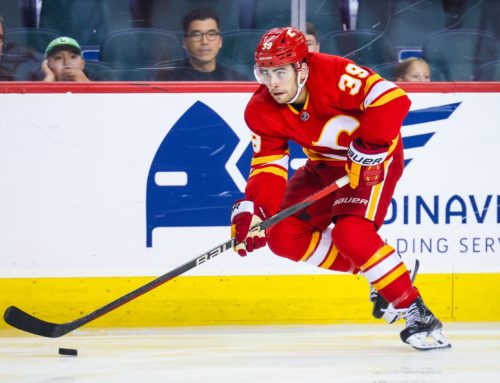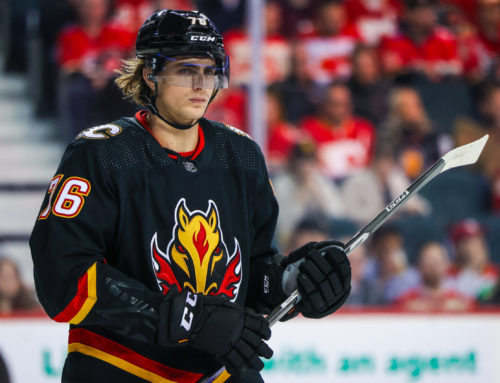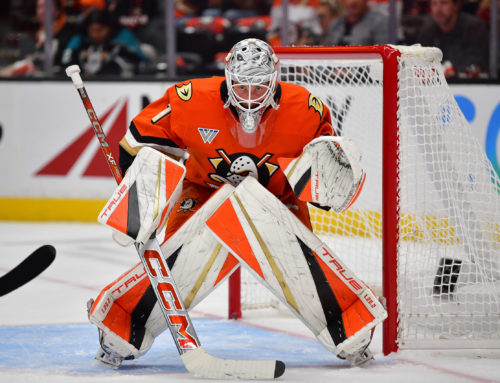
An in-depth comparison of fantasy drafting strategies.
As training camps are set to open, Fantasy Hockey managers everywhere are preparing for their upcoming drafts. Draft strategies are often debated: should I go D early? Should I focus on scoring, PIMs, shooting? Should I take the best player available or the best position? My take is always that you need to take the best VALUE available, as late as you can take it. Who that is will depend on your league settings but the best way to truly know is to put your league in FHG and let it do the math. I have often said that, while I wouldn't advocate drafting based on FHG alone, an FHG drafted team would outperform most of the general public. Today I put that hypothesis to the test and look at the "Best Player Available" strategy compared to a Fantasy Hockey Geek calculated "Best Value Available" strategy.
The way I went about performing my experiment was by running two mock drafts on Yahoo! In both cases I drafted from the 3rd slot in a 10 team Yahoo! standard league (measuring G, A, +/-, PPP, SOG, PIM). In the Best Player Available (BPA) scenario I selected the player with the highest O-Rank in every round and in the Fantasy Hockey Geek (FHG) scenario I selected the highest ranked player as per the FHG output in every round. I ran only one mock draft for each scenario to see how the results panned out.
*Note: I tried to isolate this analysis to skaters only (no goalies). In order to do this, I made sure to use the exact same picks on goalies in both scenarios (which ended up being the 4th and 6th rounds).
So my first matter of business was running the BPA scenario. Here is what we ended up with:
| Position | Player |
|---|---|
| C | Steven Stamkos |
| C | Eric Staal |
| LW | Taylor Hall |
| LW | Gabriel Landeskog |
| RW | Phil Kessel |
| RW | Ryan Kesler |
| D | Zdeno Chara |
| D | Ryan Suter |
| D | James Wisniewski |
| D | Justin Faulk |
Oh crap. One look at that team and I thought that this experiment might actually result in a huge failure. That team doesn't look like it has a single weakness and it actually has a number of "FHG-friendly" (players whose actual value exceeds public perception) names. I knew right away that the FHG team would be hard pressed to match up.
BPA: Gabriel Landeskog
FHG: Dion Phaneuf
At 63 overall BPA was able to draft Gabriel Landeskog which is a solid selection as he is calculated as the 50th most valuable player. Landeskog is an absolute multi-cat beast and the only thing preventing him from the next tier of fantasy hockey value is his low PPP.
Like Byfuglien in round 2, Dion Phaneuf in round 7 was a "reach" for me. His ADP is 116th overall and I got him 63rd overall. I certainly could have waited on Phaneuf and given the fact that I already had two stud-D I would have definitely went another direction if I were adding strategy into this process. I would have looked to a Ryan Kesler or Evander Kane knowing that I could get Phaneuf later. Today though, I wanted to stay true to the process so I nabbed Dion and as the FHG-calculated 14th most valuable player in this league I have no real complaints with that considering it's the 7th round.
Round 8:
BPA: Ryan Kesler
FHG: Scott Hartnell
Another good selection for BPA at 78 netted him Ryan Kesler who is projected to be the 57th most valuable player. Looking over the BPA draft there are actually some very solid selections but in every single case so far, the FHG draft has ended up with the better value pick. An interesting trend is developing though as the BPA team is all forwards while the FHG team is heavy on the backend.
In round 8, a Yahoo! standard league stud fell to me and I swooped in on Scott Hartnell. Scotty Harts is projected on FHG to be the 38th most valuable player in this league and I got him with the 78th pick. His PIMs are elite, while he contributes solidly across all other categories which is why he is ranked so high.
Round 9:
BPA: Zdeno Chara
FHG: Brent Burns
BPA used the first 8 picks on six forwards and two goalies so the next four picks are going to be defencemen. In this instance, BPA was able to get Zdeno Chara who is the 43rd ranked player per FHG. This is the first round in which BPA got better value than FHG. Again, I think that the BPA draft just happened to be particularly weak because Chara was gone much earlier in the FHG draft but that could also be attributed to the nature of the draft (in the FHG draft I was selecting lots of D which may have made other managers select more D. The opposite effect could be true in the BPA draft). So I'll give BPA some credit with a nice selection here.
Round 9 further exemplifies a point I alluded to earlier: the best FHG value available by far was another defenseman – Brent Burns who is projected as the 56th most valuable player. The thing is this would already be my fourth rearguard and I was falling dangerously thin up top. If it were a real draft I might have picked a lesser valued forward, knowing that I could get Burns later or maybe even settle on the 74th ranked Radko Gudas in one of the final rounds. The key with FHG is to use the data to make shrewd decisions like that yourself and not just follow down the list. For today though, I stuck to the list and I am pretty thrilled that my worst D-man is Burns.
Round 10:
BPA: Ryan Suter
FHG: Jakub Voracek
With an absolute steal, BPA was able to draft the projected 35th most valuable player here: Ryan Suter. Suter's high end production out of the D slot definitely justifies his calculated value but the fact that he was able to go so late reiterates another point that I made earlier: good value can be found late. It is important to understand (as an example) that Suter is the 35th most valuable player but that doesn't mean you need to draft him 35th. If you know you can get him in round 10 then by all means do it! Great pick by BPA here and great value.
Trying to round out my forward group the pickings were getting pretty slim. As FHG was loading up on stud D, the league was obviously taking all of the forwards. With the 98th overall pick though, I was pretty happy to land Jakub Voracek who is projected to be the 61st most valuable player in the league.
Round 11:
BPA: James Winsiewski
FHG: Henrik Sedin
In round 11, BPA's defence options were starting to run thin but we managed to find some decent value with James Wisniewski. Wiz is projected to be the 68th most valuable in this league next year and makes for a decent D3 considering BPA waited until the last possible minute to draft a D3.
It's interesting to see how the Sedin's value has changed over the years. When they were in their hay-day the Sedin's were being drafted incredibly too high – especially Henrik because of the lack of SOG and PIM. Henrik has been sliding down draft boards for years now but he is still a high-end PPP and assist guy which is why FHG calculates him as the 64th most valuable in this league; making him a great addition with the 103rd pick
Round 12:
BPA: Justin Faulk
FHG: Andrew Ladd
The final player on my starting lineup with the 118th pick was Andrew Ladd. Ladd is an incredible multi-cat contributor in almost any leagues and he continues to fly way under the radar in fantasy circles. In this league, he is projected to be the 69th most valuable player making him well worth my pick. If your league includes hits or SHP, he is going to be worth even more. I love Ladd as my LW2.
When it came time for BPA to take their D4, they were pretty much out of options and had to land on Justin Faulk who is the 111th ranked skater in this league. This one hurts a lot as the drop off is significant. Consider the difference between the FHG D4 (Brent Burns) and the ADP D4 (Justin Faulk). Burns is projected for 20% more points and 74 more shots. Now compare FHGs LW2 (Ladd) to ADPs LW2 (Landeskog). Ladd is actually projected to get 6 MORE points than Landeskog as well as 2 more PPPs. Landeskog has a slight shot and PIM advantage. In short, the drop off from Landeskog (who was drafted in the 7th) to Ladd (who was drafted in the 12th) is negligible. The drop off from
Burns (drafted in the 9th) to Faulk (drafted in the 12th) however is significant. These kinds of trade-offs are exactly thing that the FHG math accounts for when it calculates the player rankings. The rankings are critical to consider when making your draft selections.
So now that we have the two teams, let's compare Dobber's projected season totals for the two teams and see what method made out better at the draft table:

You can see here that the FHG team is projected to get more total points, PIMs, SOG and PPP (with the PIM and PPP totals being higher by a wide margin). BPA has an advantage in +/- which is a completely unreliable stat and a very slight advantage in goals. Using the math at FHG, the FHG team was able to dominate the peripheral stats while not giving up on points (in fact the FHG team is projected for MORE points). Keep in mind that we were able to accomplish this while adding 0 managerial/GM skills to the equation. If I team FHG can beat the best player available strategy simply by using the FHG rankings, imagine what could be done when some thought was added?
So what did we learn here:
- The FHG math is sound: A player's FHG value isn't the be all and end all when you are at the draft table and you should not just draft down the list like I did here. What you should do is always ensure that the pick you are using on a player is later than his FHG calculated value. As a general rule of thumb I like to pick my players slightly later than their FHG value and slightly earlier than their ADP. If you can consistently do that you are going to be in fantastic shape.
- Going off of the FHG rankings will often leave you heavily weighted towards D: People everywhere underrate D so the high end D will always be available much later than they should be. The best strategy would be to use this to your advantage and grab one or two top end guys early. For your last one or two D slots though, you can likely afford to wait a little while longer than the FHG value ranks would indicate. You still have to manage the draft that you are in and make the right choices to not miss out on what you need but you should do so with the added knowledge of players' values that you get from FHG.
- In some cases, it seems just drafting the Yahoo! O-rank might outperform a lot of the general public. In BPA's draft, it seems to me that the O-Rank had a better understanding of real value than the public who was drafting. This tells me that there is a huge opportunity to win a lot of pools out there if you employ the FHG math.
- There are plenty of flaws to my experiment here (quality of draft competition, sample size of one draft etc etc) and I am not here to tell you that this study is absolutely conclusive. What I am saying is that the concepts demonstrated in this exercise are valuable and there are key lessons that we can learn here that will help you in your draft.
- Understanding the FHG rankings is of paramount importance to your draft strategy, but the FHG rankings are not a draft list: You can see above that just going off the FHG rankings was indeed good enough to outperform the Best Player Available strategy which was also better than what the general public was doing which is great…but that's not good enough for me. Armed with FHG information you should be able to outperform the "Best Player Available" strategy by a much more considerable margin. Imagine if I had taken Byfulglein in the 7th (2 rounds prior to his ADP) and taken Taylor Hall in the second round instead of Buff? Using my draft skills in combination with the FHG data my team would have been even stronger and dominated the BPA team by an even greater margin. That's what we should all be aiming to do.
If you are still reading this lengthy article, hopefully you were able to learn a thing or two that will help you at the draft table. Understanding players' true value and using that information to draft the player at the exact right time is how you are going to win your draft. Fantasy Hockey Geek is a great resource to help you do this. Sign up today, enter your league settings and come to the draft armed with the info. Then use your draft skills to utilize this invaluable information and do some serious damage to your opponents at the draft.





 EDM
EDM FLA
FLA CHI
CHI ANA
ANA CGY
CGY WPG
WPG
